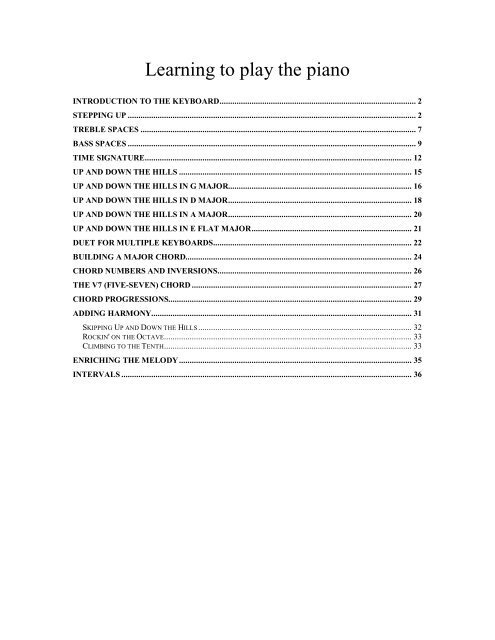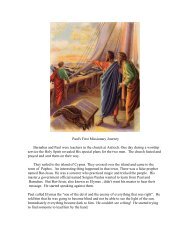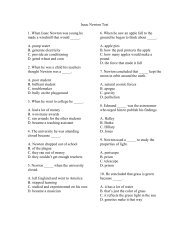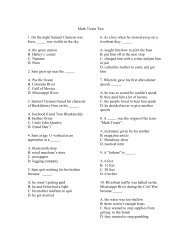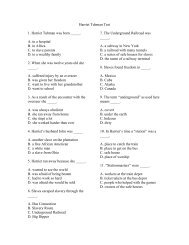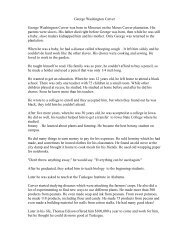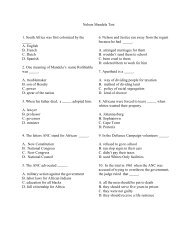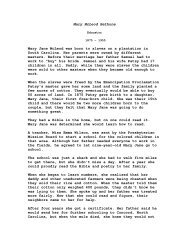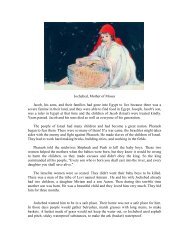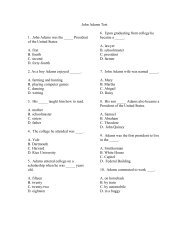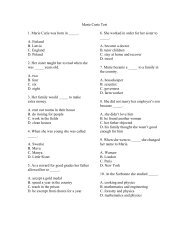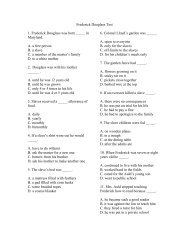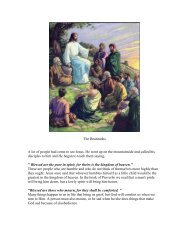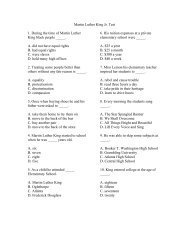Learning to play the piano - Garden of Praise
Learning to play the piano - Garden of Praise
Learning to play the piano - Garden of Praise
- No tags were found...
You also want an ePaper? Increase the reach of your titles
YUMPU automatically turns print PDFs into web optimized ePapers that Google loves.
http://www.garden<strong>of</strong>praise.com/keybdles.htmINTRODUCTION <strong>to</strong> <strong>the</strong> KEYBOARDThe keyboard is made up <strong>of</strong> white keys with repeating patterns <strong>of</strong> black keys in groups <strong>of</strong>two and three.We use seven letters <strong>of</strong> <strong>the</strong> alphabet <strong>to</strong> make music; A,B,C,D,E,F, and G. After G, westart over again with A.Look at <strong>the</strong> group <strong>of</strong> two black keys. C will always be <strong>to</strong> <strong>the</strong> left <strong>of</strong> <strong>the</strong> two black keys. Ewill always be <strong>to</strong> <strong>the</strong> right <strong>of</strong> <strong>the</strong> two black keys. And D is right in <strong>the</strong> middle <strong>of</strong> <strong>the</strong> twoblack keys.Now look at <strong>the</strong> group <strong>of</strong> three black keys. F will always be <strong>to</strong> <strong>the</strong> left <strong>of</strong> <strong>the</strong> three blackkeys. B will always be <strong>to</strong> <strong>the</strong> right <strong>of</strong> <strong>the</strong> three black keys.Each key on <strong>the</strong> keyboard has a particular <strong>to</strong>ne or pitch, and a certain place on <strong>the</strong> musicstaff. You will learn how each <strong>to</strong>ne relates <strong>to</strong> a line or space, and you will be able <strong>to</strong> findit on <strong>the</strong> keyboard and combine <strong>the</strong> notes <strong>to</strong> make beautiful music.STEPPING UPIf you do not have a musical keyboard near your computer, make a copy <strong>of</strong> <strong>the</strong> mockkeyboard as directed on <strong>the</strong> first page <strong>of</strong> <strong>the</strong>se lessons. It will be helpful <strong>to</strong> you inlearning <strong>the</strong> keyboard.When <strong>the</strong> notes on <strong>the</strong> staff go from a line <strong>to</strong> a space or from a space <strong>to</strong> a line, we step upor down <strong>to</strong> <strong>the</strong> next note letter.In <strong>the</strong> first measure we begin with <strong>the</strong> thumb <strong>of</strong> <strong>the</strong> right hand on <strong>the</strong> red-dotted middle C(line). Step up <strong>to</strong> D (space), <strong>the</strong>n <strong>to</strong> E (line).In <strong>the</strong> second measure, <strong>the</strong> third finger is on E (line). Step down <strong>to</strong> D (space), <strong>the</strong>n backdown <strong>to</strong> C (line).This song is written in 4/4 time which means that we count 1,2,3,4 and <strong>the</strong> black notewith a stem (quarter note) gets one count. The white note with a stem (half note) gets 2counts.2
This song begins with <strong>the</strong> thumb <strong>of</strong> <strong>the</strong> left hand on middle C. In <strong>the</strong> first measure westep down from middle C (line) <strong>to</strong> B (space) <strong>to</strong> A (line). In <strong>the</strong> second measure, <strong>the</strong> thirdfinger is on A (line). Step up <strong>to</strong> B (space), <strong>the</strong>n back up <strong>to</strong> C (line).Count 1,2,3,4 as you did in <strong>the</strong> previous song.3
Try this sight reading exercise. First <strong>play</strong> <strong>the</strong> right hand alone. Say <strong>the</strong> names <strong>of</strong> <strong>the</strong>notes. Then <strong>play</strong> left hand alone and say <strong>the</strong> names <strong>of</strong> <strong>the</strong> notes.Begin with <strong>the</strong> thumb <strong>of</strong> <strong>the</strong> right hand on middle C with a red dot (line). Step up <strong>to</strong> D(space), <strong>the</strong>n up <strong>to</strong> E (line), up <strong>to</strong> <strong>the</strong> next key F (space) and on up <strong>to</strong> <strong>the</strong> next one, G(line). Your 5th finger (little finger) will be on G.G is a white note with no stem. We call this a whole note and it gets all 4 counts in 4/4time. In <strong>the</strong> 6th measure we have two G's that are white notes with stems (half notes).Each <strong>of</strong> <strong>the</strong>se notes gets two counts.4
***Begin with <strong>the</strong> thumb <strong>of</strong> <strong>the</strong> left hand on middle C. In <strong>the</strong> first measure we step downfrom middle C (line) <strong>to</strong> B (space) <strong>to</strong> A (line), <strong>to</strong> G (space) <strong>to</strong> F (line). Your 5th finger(little finger) is on F in <strong>the</strong> bass clef.In <strong>the</strong> second measure, <strong>the</strong> 5th finger is on F (line). Step up <strong>to</strong> G (space), <strong>the</strong>n up <strong>to</strong> A(line), up <strong>to</strong> B (space) and back up <strong>to</strong> middle C (line).Count 1,2,3,4 as you did in <strong>the</strong> previous songs.5
***6
TREBLE SPACESThe treble spaces spell <strong>the</strong> word "face" F,A,C,E. The first space F is <strong>the</strong> first F abovemiddle C. The distance from a space <strong>to</strong> a space is a "skip". You skip a letter when naming<strong>the</strong> notes.Your teacher may use a signal <strong>to</strong> remind you <strong>of</strong> <strong>the</strong>se notes. Here's one I use. Put youropen palm in front <strong>of</strong> your face. Rotate it as if washing a window. This will remind youthat <strong>the</strong> treble spaces spell "face", F,A,C,E.7
To help us remember <strong>the</strong> treble lines we say, "Every Good Boy Does Fine". The names<strong>of</strong> <strong>the</strong> line notes in <strong>the</strong> treble are E,G,B,D,F. From one line <strong>to</strong> <strong>the</strong> next is a "skip". Westart on <strong>the</strong> E above middle C (with a red circle) and we skip a letter name as <strong>the</strong> notesascend, or go up.Our signal for this reminder is <strong>the</strong> American Sign Language sign for "boy". Pretend youare wearing a cap with a bill on it. Touch <strong>the</strong> "bill" and move <strong>the</strong> hand down and awayfrom <strong>the</strong> face. This sign for "boy" reminds us that "Every Good Boy Does Fine",E,G,B,D,F, <strong>the</strong> treble lines.8
***BASS SPACESWe remember <strong>the</strong> bass spaces by saying, "All Cars Eat Gas", A,C,E,G. These are <strong>the</strong> bassspaces. The A is <strong>the</strong> second A below middle C (circled in red). We "skip" from space <strong>to</strong>space, skipping a letter name in between.Let's learn a signal. Pretend you have a steering wheel in your hands. Turn <strong>the</strong> wheel asyou "drive". This will remind you that "All Cars Eat Gas", A,C,E,G, <strong>the</strong> bass spaces.9
***The bass lines can be remembered with "Great Big Dogs Fight Animals" G,B,D,F,A. Thefirst line in <strong>the</strong> bass is <strong>the</strong> second G below middle C (circled in red). We "skip" from line<strong>to</strong> line, skipping a letter in between <strong>to</strong> find <strong>the</strong>se new notes.To remember <strong>the</strong> signal for <strong>the</strong> lines say "Grrr" like an angry dog. This will help you <strong>to</strong>recall that "Great Big Dogs Fight Animals", G,B,D,F,A; <strong>the</strong> bass lines10
***11
TIME SIGNATUREThe time signature, or meter, tells us how <strong>to</strong> count <strong>the</strong> music. The <strong>to</strong>p number shows howmany beats <strong>to</strong> count in each measure. The bot<strong>to</strong>m number tells us <strong>the</strong> kind <strong>of</strong> note thatgets one count.If <strong>the</strong> <strong>to</strong>p number is 4:If <strong>the</strong> <strong>to</strong>p number is 3:If <strong>the</strong> <strong>to</strong>p number is 6:There are o<strong>the</strong>r meters, but <strong>the</strong>se are <strong>the</strong> three most common and we will be studyingthose signatures.In <strong>the</strong> following examples observe that a:a white notewith no stema white notewith a stem12a black notewith a stema black notewith a stemand one flag
This example is in 4/4 time. A whole note gets all 4 beats, a half note gets 2 beats, aquarter note gets 1 beat and 2 eighth notes make one beat.The next example is in 3/4 time. A quarter note gets 1 beat, a half note 2 beats and <strong>the</strong>dot after <strong>the</strong> half adds half <strong>of</strong> <strong>the</strong> value <strong>to</strong> <strong>the</strong> count, so a dotted half gets 2+1 or 3 beats.It takes 2 eighth notes <strong>to</strong> make a beat.The third example is in 6/8 time. An eighth note gets 1 beat and a quarter note gets 2beats. A dotted half gets all 6 beats (4+2=6).We can raise and lower pitches by putting a sign in front <strong>of</strong> <strong>the</strong> note, or by putting sharpsor flats in <strong>the</strong> key signature which appears at <strong>the</strong> beginning <strong>of</strong> each music staff.A sharp raises a note by one-half step (<strong>the</strong> very next key <strong>to</strong> <strong>the</strong> right). The raised notemay be a black key, or it may be a white key, but <strong>the</strong> sharp will be <strong>to</strong> <strong>the</strong> right <strong>of</strong> <strong>the</strong>original pitch. In this lesson all sharps will be on <strong>the</strong> black keys.A flat lowers a note by one-half step (<strong>the</strong> very next key <strong>to</strong> <strong>the</strong> left). It may be a black or awhite key, but in this lesson all flats will be black keys.A natural res<strong>to</strong>res <strong>the</strong> note <strong>to</strong> its original pitch without <strong>the</strong> sharp or flat.13
UP AND DOWN THE HILLSWe will learn this exercise first in <strong>the</strong> key <strong>of</strong> C Major with no sharps or flats. You willneed <strong>to</strong> place your hands in <strong>the</strong> C Major position. The thumb <strong>of</strong> your right hand will beon middle C and <strong>the</strong> little finger <strong>of</strong> your left hand will be on <strong>the</strong> C below middle C.We will count 1,2,3,4.When you learn <strong>the</strong> exercise well, you can move your hands up eight notes (an octave)and your teacher or your friend can <strong>play</strong> <strong>the</strong> au<strong>to</strong>matic chords which are noted above <strong>the</strong>staff. Next a rhythm can be added for more enjoyment. Start out with a metronomemarking <strong>of</strong> 70 and gradually increase your speed.15
UP AND DOWN THE HILLS IN G MAJORThis exercise is in <strong>the</strong> key <strong>of</strong> G Major. There is one sharp in <strong>the</strong> key signature, but <strong>the</strong>reare no F's in <strong>the</strong> song, so all <strong>the</strong> notes will be on <strong>the</strong> white keys. You will need <strong>to</strong> placeyour hands in <strong>the</strong> G Major position. The thumb <strong>of</strong> your right hand will be on G abovemiddle C, and <strong>the</strong> little finger <strong>of</strong> your left hand will be on <strong>the</strong> G below middle C.We will count 1,2,3,4.In measures 11, 12, and 15 you will see <strong>the</strong> D next <strong>to</strong> middle C written as a leger line, aline added between <strong>the</strong> treble and bass staff. You find it as you step up from middle C.When you learn <strong>the</strong> exercise well, you can move your hands up eight notes (an octave)and your teacher or your friend can <strong>play</strong> <strong>the</strong> au<strong>to</strong>matic chords and rhythm <strong>to</strong> accompanyyou.16
This exercise is in <strong>the</strong> key <strong>of</strong> F Major. There is one flat in <strong>the</strong> key signature, and that flatis Bb. Your first B flat will be in <strong>the</strong> second measure. You will <strong>play</strong> <strong>the</strong> black key <strong>to</strong> <strong>the</strong>left <strong>of</strong> B. You will need <strong>to</strong> place your hands in <strong>the</strong> F Major position. The thumb <strong>of</strong> yourright hand will be on F above middle C, and <strong>the</strong> little finger <strong>of</strong> your left hand will be on<strong>the</strong> F below middle C.We will count 1,2,3,4.In this exercise you may circle all <strong>the</strong> B's with a pencil <strong>to</strong> remind you <strong>to</strong> flat those notes.When you learn <strong>the</strong> exercise well, you can move your hands up eight notes (an octave)and your teacher or your friend can <strong>play</strong> <strong>the</strong> au<strong>to</strong>matic chords and rhythm <strong>to</strong> accompanyyou.17
UP AND DOWN THE HILLS IN D MAJORThis exercise is in <strong>the</strong> key <strong>of</strong> D Major. There are two sharps in <strong>the</strong> key signature.In <strong>the</strong>key <strong>of</strong> D Major, all <strong>the</strong> F's and C's will be sharped. In this exercise <strong>the</strong> first F# is in <strong>the</strong>second measure. There will be no C's. You will need <strong>to</strong> place your hands in <strong>the</strong> D Majorposition. The thumb <strong>of</strong> your right hand will be on D above middle C, and <strong>the</strong> little finger<strong>of</strong> your left hand will be on <strong>the</strong> D below middle C.We will count 1,2,3,4.In this exercise you may circle all <strong>the</strong> F's with a pencil <strong>to</strong> remind you <strong>to</strong> sharp thosenotes.When you learn <strong>the</strong> exercise well, you can move your hands up eight notes (an octave)and your teacher or your friend can <strong>play</strong> <strong>the</strong> au<strong>to</strong>matic chords and rhythm <strong>to</strong> accompanyyou.18
This exercise is in <strong>the</strong> key <strong>of</strong> B Flat Major. There are two flats in <strong>the</strong> key signature, andthose flats are B flat and E flat. You will need <strong>to</strong> place your hands with <strong>the</strong> thumb <strong>of</strong> yourright hand on <strong>the</strong> B flat <strong>to</strong> <strong>the</strong> left <strong>of</strong> middle C. This is ano<strong>the</strong>r way <strong>to</strong> write <strong>the</strong> B next <strong>to</strong>middle C by using a leger line between <strong>the</strong> staffs. The little finger <strong>of</strong> your left hand willbe on <strong>the</strong> second B flat below middle C. (This fingering is somewhat awkward and wewill learn a better one later.)We will count 1,2,3,4.In this exercise you may circle all <strong>the</strong> B's and E's with a pencil <strong>to</strong> remind you <strong>to</strong> flat thosenotes.When you learn <strong>the</strong> exercise well, you can move your hands up eight notes (an octave)and your teacher or your friend can <strong>play</strong> <strong>the</strong> au<strong>to</strong>matic chords and rhythm <strong>to</strong> accompanyyou.19
UP AND DOWN THE HILLS IN A MAJORThis exercise is in <strong>the</strong> key <strong>of</strong> A Major. There are three sharps in <strong>the</strong> key signature, andthose sharps are F#, C#, and G#. C# will be used in this exercise, but <strong>the</strong> o<strong>the</strong>r two willnot.You will need <strong>to</strong> place your hands with <strong>the</strong> thumb <strong>of</strong> your right hand on <strong>the</strong> A abovemiddle C. The little finger <strong>of</strong> your left hand will be on <strong>the</strong> A below middle C.There will be notes on <strong>the</strong> leger lines between <strong>the</strong> treble and bass staffs. Those notes willbe <strong>the</strong> D and E right above middle C.We will count 1,2,3,4.In this exercise you may circle all <strong>the</strong> C's with a pencil <strong>to</strong> remind you <strong>to</strong> sharp thosenotes.When you learn <strong>the</strong> exercise well, you can move your hands up eight notes (an octave)and your teacher or your friend can <strong>play</strong> <strong>the</strong> au<strong>to</strong>matic chords and rhythm <strong>to</strong> accompanyyou.20
UP AND DOWN THE HILLS IN E FLAT MAJORPlay this exercise is in <strong>the</strong> key <strong>of</strong> E Flat Major. There are three flats in <strong>the</strong> key signature,and <strong>the</strong>y are B flat, E flat and A flat. You begin on <strong>the</strong> black key <strong>of</strong> E flat. You will useall three <strong>of</strong> <strong>the</strong> flats. You will need <strong>to</strong> place your hands in <strong>the</strong> E Flat Major position. Thethumb <strong>of</strong> your right hand will be on E flat above middle C, and <strong>the</strong> little finger <strong>of</strong> yourleft hand will be on <strong>the</strong> E flat below middle C.We will count 1,2,3,4.In this exercise you may circle all <strong>the</strong> E's, A's, and B's with a pencil <strong>to</strong> remind you <strong>to</strong> flatthose notes.When you learn <strong>the</strong> exercise well, you can move your hands up eight notes (an octave)and your teacher or your friend can <strong>play</strong> <strong>the</strong> au<strong>to</strong>matic chords and rhythm <strong>to</strong> accompanyyou.21
DUET FOR MULTIPLE KEYBOARDSThis first duet can be <strong>play</strong>ed on two or more keyboards. There is a first part, Primo (PREmoe), and a second part, Secondo (se KON doe). Each student learns his/her part, <strong>the</strong>n<strong>the</strong>y <strong>play</strong> <strong>the</strong> parts <strong>to</strong>ge<strong>the</strong>r, beginning slowly and gradually increasing <strong>the</strong> tempo.22
Can you <strong>play</strong> <strong>the</strong> same exercise in o<strong>the</strong>r keys? Remember how we changed our handposition and changed <strong>the</strong> key when we <strong>play</strong>ed "Up and Down <strong>the</strong> Hills"?When we change <strong>the</strong> key <strong>of</strong> a song, we say we transpose <strong>the</strong> song.Transpose this song <strong>to</strong> <strong>the</strong> major keys <strong>of</strong> G, F, D, B Flat, A, and E Flat.On <strong>the</strong> keyboard:A half-step is <strong>the</strong> distance from one key <strong>to</strong> <strong>the</strong> next. It may be a white key, or it may be ablack key.A whole-step is made up <strong>of</strong> two half-steps.A Major Scale if built on a pattern <strong>of</strong> whole-step, whole-step, half-step, whole-step, whole-step, whole-step, half-step,23
Study and <strong>play</strong> <strong>the</strong> C Major scale below. Say <strong>the</strong> pattern <strong>of</strong> steps as you <strong>play</strong>.Right hand fingering: 1,2,3,(thumb under) 1,2,3,4,5.Left hand fingering: 5,4,3,2,1,(third finger over) 3,2,1.BUILDING A MAJOR CHORDIn this lesson you will learn <strong>to</strong> build a triad. A triad is made <strong>of</strong> three <strong>to</strong>nes which aresounded at <strong>the</strong> same time. In <strong>the</strong> key <strong>of</strong> C Major, we will build our first triad (chord) onC.Put your left finger on C, and with your right hand count up 4 half-steps. ( A half-step is<strong>the</strong> distance from one key <strong>to</strong> <strong>the</strong> next. It doesn't matter whe<strong>the</strong>r that key is black orwhite.) So we start going up by half-steps; C#, D, D#, E, (1,2,3,4). We have gone up 4half-steps and we are now on E. E is <strong>the</strong> next note <strong>of</strong> our triad.Now hold down <strong>the</strong> E with your left finger and count up 3 half-steps with your righthand; F, F#, G, (1,2,3). You are now on G and G is <strong>the</strong> <strong>to</strong>p note <strong>of</strong> <strong>the</strong> triad.Now <strong>play</strong> <strong>the</strong> three notes <strong>to</strong>ge<strong>the</strong>r; C,E,G. This is <strong>the</strong> C Major chord or triad inroot position. C is <strong>the</strong> low (bot<strong>to</strong>m) note <strong>of</strong> <strong>the</strong> chord.All major chords in root position will have this pattern <strong>of</strong> 4 half-steps and 3 half-steps. If<strong>the</strong> bot<strong>to</strong>m note is on a line, <strong>the</strong> chord will be line-line-line. If <strong>the</strong> bot<strong>to</strong>m note is on aspace, <strong>the</strong> chord will be space-space-space.In ano<strong>the</strong>r lesson we will learn how <strong>to</strong> invert or turn <strong>the</strong> chords around.24
Using <strong>the</strong> same pattern <strong>of</strong> 4 half-steps plus 3 half-steps, you can build major chords onany key.25
CHORD NUMBERS AND INVERSIONSWe can build a major chord on each note <strong>of</strong> <strong>the</strong> scale. We can use Roman numerals <strong>to</strong>mark <strong>the</strong>m. If <strong>the</strong> chord is built on <strong>the</strong> first note <strong>of</strong> <strong>the</strong> scale, we call it a I (One) chord.If <strong>the</strong> chord is built on <strong>the</strong> 4th note <strong>of</strong> <strong>the</strong> scale, we call it a IV (Four) chord.If it is built on <strong>the</strong> 5th note <strong>of</strong> <strong>the</strong> scale, we call it a V (Five) chord.In C Major, C is <strong>the</strong> first note <strong>of</strong> <strong>the</strong> scale, so we build <strong>the</strong> I (One) chord on C.F is <strong>the</strong> 4th note <strong>of</strong> <strong>the</strong> scale, so we build <strong>the</strong> IV (Four) chord on F.G is <strong>the</strong> 5th note <strong>of</strong> <strong>the</strong> scale, so let's build <strong>the</strong> V (Five) chord on G.After we build <strong>the</strong> chords in root position, we can change <strong>the</strong> notes around.Instead <strong>of</strong> a C,E,G chord, we can put <strong>the</strong> E as <strong>the</strong> bot<strong>to</strong>m note and we now have E,G,C as<strong>the</strong> <strong>to</strong>nes <strong>of</strong> <strong>the</strong> chord. We call this <strong>the</strong> first inversion <strong>of</strong> <strong>the</strong> chord.Put <strong>the</strong> G on <strong>the</strong> bot<strong>to</strong>m <strong>to</strong> make a G,C,E chord and this is <strong>the</strong> second inversion <strong>of</strong> <strong>the</strong>chord.26
THE V7 (FIVE-SEVEN) CHORDWhen you build a V (Five) chord in C Major, <strong>the</strong> bot<strong>to</strong>m note is G because G is <strong>the</strong> 5thnote <strong>of</strong> <strong>the</strong> C Major scale. We know that <strong>the</strong> G chord is made up <strong>of</strong> <strong>the</strong> notes G,B, and D.Now if you add <strong>the</strong> 7th <strong>to</strong>ne <strong>of</strong> <strong>the</strong> scale, F, you have a nice sound for harmony. We caninvert <strong>the</strong> chord and sometimes we leave out one <strong>of</strong> <strong>the</strong> <strong>to</strong>nes.To move from <strong>the</strong> I (One) chord <strong>to</strong> <strong>the</strong> V7 (Five-seven) chord: keep <strong>the</strong> <strong>to</strong>p note <strong>the</strong> same move <strong>the</strong> middle note up one-half step move <strong>the</strong> bot<strong>to</strong>m note down one-half step.27
You can now <strong>play</strong> Mary Had a Little Song using <strong>the</strong> progression you learned in thislesson.Learn <strong>to</strong> <strong>play</strong> <strong>the</strong> melody <strong>of</strong> this song with your right hand alone, <strong>the</strong>n you can addchords with your left hand.You will use <strong>the</strong> C chord <strong>to</strong> <strong>the</strong> G7 chord progression.The last note <strong>of</strong> <strong>the</strong> song is Low C which is 2 octaves below middle C.The au<strong>to</strong>matic chords are written above <strong>the</strong> treble staff. Add a rhythm such as a ballad.Begin ver-r-ry slowly with a metronome speed <strong>of</strong> 60. When you can <strong>play</strong> it well at thatspeed, <strong>the</strong>n try it faster.28
CHORD PROGRESSIONSIn this lesson we will learn <strong>the</strong> chord progression I (One), IV (Four), I, V7 (Five-Seven),I.This series <strong>of</strong> chords if very useful when harmonizing songs.In <strong>the</strong> key <strong>of</strong> C Major, <strong>the</strong> I (One) chord is C,E,G. This is <strong>the</strong> root position. Play thatchord.Keep <strong>the</strong> bot<strong>to</strong>m note where it is. Move <strong>the</strong> middle <strong>to</strong>ne up one-half step, and move <strong>the</strong><strong>to</strong>p <strong>to</strong>ne up two half-steps (one whole step). Now you are <strong>play</strong>ing C,F,A. This is <strong>the</strong> IV(Four) chord (second inversion).Go back <strong>to</strong> <strong>the</strong> I chord in root position; C,E,G.Now move <strong>to</strong> <strong>the</strong> V7 (Five-Seven) chord by keeping <strong>the</strong> <strong>to</strong>p note in place and move <strong>the</strong>middle <strong>to</strong>ne up one-half step, and <strong>the</strong> bot<strong>to</strong>m <strong>to</strong>ne down one-half step, as we learned in<strong>the</strong> previous lesson.Now go back <strong>to</strong> <strong>the</strong> I chord in root position.First <strong>play</strong> it with <strong>the</strong> left hand, <strong>the</strong>n with <strong>the</strong> right hand, and <strong>the</strong>n with both hands.Play this progression in o<strong>the</strong>r keys .29
You can now <strong>play</strong> America using <strong>the</strong> progression you learned in this lesson.Learn <strong>to</strong> <strong>play</strong> <strong>the</strong> melody <strong>of</strong> this song with your right hand alone, <strong>the</strong>n you can addchords with your left hand.Use correct fingering (<strong>the</strong> numbers between <strong>the</strong> treble and bass staves) and you will havea smooth melody.If you like, you can <strong>play</strong> <strong>the</strong> melody an octave lower beginning on middle C.Add a rhythm such as a ballad. Begin ver-r-ry slowly with a metronome speed <strong>of</strong> 60.When you can <strong>play</strong> it well at that speed, <strong>the</strong>n try it faster.30
ADDING HARMONYThere are many different ways <strong>to</strong> use chords <strong>to</strong> add harmony <strong>to</strong> a melody. We will studysome examples and <strong>the</strong>n <strong>play</strong> <strong>the</strong> chords in different keys.You will soon be able <strong>to</strong> tell whe<strong>the</strong>r you need a I (One ) chord, a IV (Four) chord, or aV7 (Five-Seven) chord <strong>to</strong> harmonize with <strong>the</strong> notes. You may even find new ways <strong>to</strong> addharmony <strong>to</strong> your songs.You will learn how <strong>to</strong> use chords in different ways <strong>to</strong> harmonize in 4/4 time, 3/4 time,and 6/8 time..Oom Pah in 4/4 TimeUse this simple "Oom Pah in 4/4 Time" for many melodies. Use <strong>the</strong> three notes <strong>of</strong> <strong>the</strong> CMajor triad <strong>to</strong> create an "Oom Pah" with <strong>the</strong> left hand.31
Skipping Up and Down <strong>the</strong> HillsWe can use "Skipping Up and Down <strong>the</strong> Hills" in 4/4 time. Use <strong>the</strong> Major triads <strong>to</strong> <strong>play</strong> anote on each beat <strong>of</strong> <strong>the</strong> measure.32
Rockin' on <strong>the</strong> OctaveWhen "Rockin' on <strong>the</strong> Octave", <strong>play</strong> <strong>the</strong> root, <strong>the</strong> 5th, <strong>the</strong> root note an octave higher, andback <strong>to</strong> <strong>the</strong> 5th.Climbing <strong>to</strong> <strong>the</strong> Tenth"Climbing <strong>to</strong> <strong>the</strong> Tenth" makes a nice harmony. You could also use it in a 3/4 time.33
Oom Pah Pah in 3/4 TimeUse this pattern <strong>to</strong> add harmony <strong>to</strong> songs written in 3/4 or waltz time. Try it with HappyBirthday or My Country Tis <strong>of</strong> Thee .Broken Triads in 6/8 TimeUse <strong>the</strong>se broken triads <strong>to</strong> harmonize songs in 6/8 time.34
Oom Pah Pah in 6/8 TimeUse this pattern for 6/8 Time. The quarter note will get two beats and <strong>the</strong> eighth note onebeat.Enriching <strong>the</strong> MelodyUse this method <strong>to</strong> make <strong>the</strong> melody sound fuller. Add some chords in differentinversions with <strong>the</strong> melody as <strong>the</strong> <strong>to</strong>p note <strong>of</strong> <strong>the</strong> chord.35
INTERVALSAn interval is <strong>the</strong> distance from one <strong>to</strong>ne <strong>to</strong> <strong>the</strong> next. We refer <strong>to</strong> intervals with ordinalwords such as second, third etc.We will be learning about major intervals. You will learn <strong>to</strong> hear <strong>the</strong>m, <strong>play</strong> <strong>the</strong>m, andsing <strong>the</strong>m.First you need <strong>to</strong> learn <strong>to</strong> <strong>play</strong> and sing <strong>the</strong> C Major scale. Sing 1,2,3,4,5,6,7,8.(Click on <strong>the</strong> speaker <strong>to</strong> hear <strong>the</strong> C Major scale.)36
SECONDFrom C <strong>to</strong> D is <strong>the</strong> interval <strong>of</strong> a 2nd. These are <strong>the</strong> first two notes when you sing Doe, adeer, a female deer. from <strong>the</strong> Do, Re, Mi song. Play and sing <strong>the</strong> interval <strong>of</strong> a second.THIRDFrom C <strong>to</strong> E is <strong>the</strong> interval <strong>of</strong> a 3rd. E is <strong>the</strong> middle <strong>to</strong>ne <strong>of</strong> a major chord. Play thischord: C,E,G,E,C, and sing 1,3,5,3,1. You hear <strong>the</strong> 3rd when you sing 1,3 . Play and sing<strong>the</strong> interval <strong>of</strong> a third.FOURTHFrom C <strong>to</strong> F is <strong>the</strong> interval <strong>of</strong> a 4th. You hear this interval when you sing I've been workingon <strong>the</strong> Railroad Play and sing <strong>the</strong> interval <strong>of</strong> a fourth.FIFTHFrom C <strong>to</strong> G is <strong>the</strong> interval <strong>of</strong> a 5th. Listen for this interval when you sing Twinkle,twinkle little star.. Play and sing <strong>the</strong> interval <strong>of</strong> a fifth.SIXTHFrom C <strong>to</strong> A is <strong>the</strong> interval <strong>of</strong> a 6th. This is one <strong>to</strong>ne above <strong>the</strong> 5th. You can find <strong>the</strong> 6thby singing Old McDonald had a farm, E, I,E,I,O From "farm" <strong>to</strong> "E" is a 6th. Play andsing <strong>the</strong> interval <strong>of</strong> a sixth.SEVENTHFrom C <strong>to</strong> B is a 7th. This is a hard one <strong>to</strong> find and sing. Practice singing a 7th.EIGHTH (OCTAVE)From C <strong>to</strong> C is <strong>the</strong> interval <strong>of</strong> an octave. This is <strong>the</strong> same <strong>to</strong>ne eight notes higher. Whenyou are singing <strong>the</strong> Happy Birthday song and you get <strong>to</strong> <strong>the</strong> part Happy birth- day dearSo-and-So, <strong>the</strong> octave is <strong>the</strong> "happy, birth-". Play and sing <strong>the</strong> interval <strong>of</strong> an octave.37


